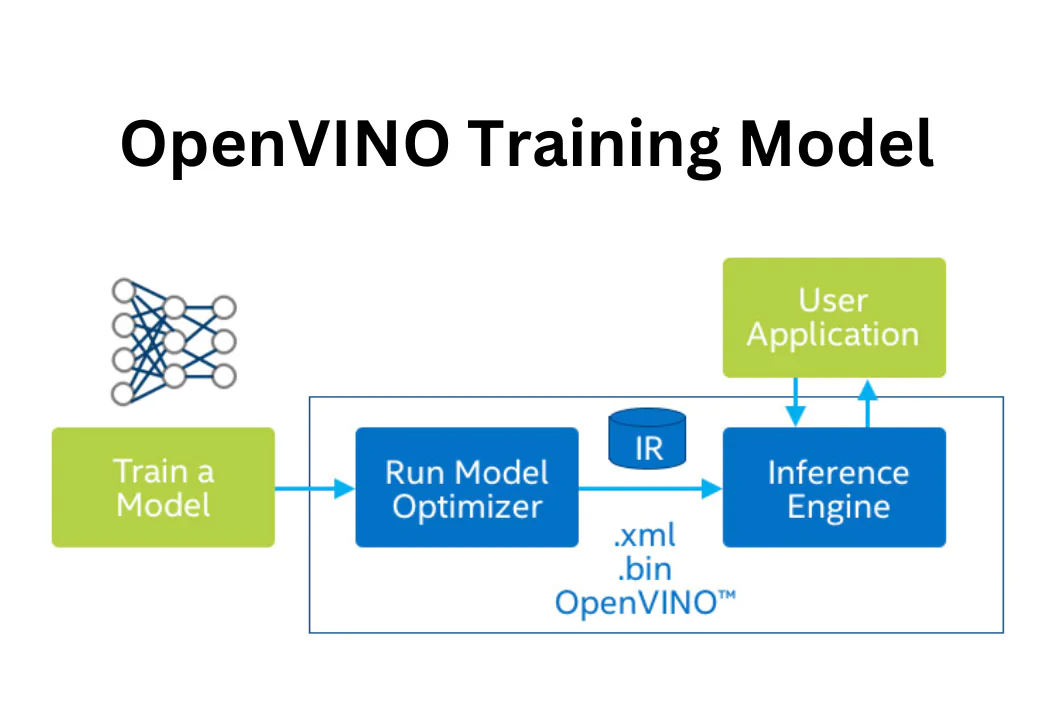OpenVINO is an open-source software development kit (SDK) that is used for computer vision and deep learning applications. It helps programmers to enhance performance and efficiency by optimizing their apps for Intel hardware.
Introduction to OpenVINO
What is OpenVINO?
Intel created OpenVINO, a cross-platform deep learning toolkit. “Open Visual Inference and Neural Network Optimization” is what the name stands for. OpenVINO is a neural network inference optimization tool that includes a post-training optimization tool and is designed to be written once and deployed anywhere on Intel hardware platforms.
Understanding the Basics
OpenVINO, short for Open Visual Inference and Neural Network Optimization, is a toolkit designed to accelerate deep learning inference on a variety of Intel hardware. It provides developers with tools and libraries to optimize and deploy AI models across different platforms efficiently.
Overview of OpenVINO Features
The key features of OpenVINO include model optimization, hardware acceleration, flexibility in deployment, and support for various frameworks such as TensorFlow, Caffe, and ONNX. It is also being used in many enterprises.

Why we use OpenVINO?
With OpenVINO, optimizing DNN models for inference is made simple and effective by integrating multiple tools, such as the capacity to read models in widely used formats, which guarantees optimal performance on Intel hardware.
Across Intel hardware, the OpenVINO toolkit supports workloads related to computer vision and non-computer vision. It speeds up the development of new applications and maximizes performance. With the use of pre-optimized kernels and a library of preset functions, OpenVINO seeks to expedite AI workloads and time to market.
Benefits of Using OpenVINO
-
Improved performance by leveraging hardware capabilities
-
Reduced development time and costs through streamlined workflows
-
Compatibility with a wide range of AI models and frameworks
Optimizing Workflows with OpenVINO

Integration with Various Platforms
OpenVINO supports integration with CPUs, GPUs, FPGAs, and VPUs, allowing developers to leverage the full processing power of Intel hardware for AI inference tasks. This comprehensive compatibility ensures that developers can tailor their solutions to the specific hardware configurations available, optimizing performance and resource utilization.
Enhancing Performance through Model Optimization
One of the paramount benefits of OpenVINO lies in its capability to enhance AI model performance through a myriad of optimization techniques.
By using techniques such as quantization, pruning, and model compression, developers can optimize their AI models for faster and more efficient inference with OpenVINO.
Streamlining Deployment Processes
OpenVINO simplifies the deployment of AI applications by providing tools for converting, optimizing, and deploying models on edge devices, servers, and the cloud. Whether deploying on edge devices, servers, or cloud platforms, OpenVINO offers a unified framework that simplifies the entire deployment lifecycle. Through its robust set of APIs and libraries, developers can effortlessly convert models trained in popular frameworks such as TensorFlow, PyTorch, or ONNX into optimized representations compatible with Intel hardware.
How OpenVINO Works on High Level

At a high level, OpenVINO (Open Visual Inference and Neural network Optimization) serves as a comprehensive toolkit designed to accelerate the development and deployment of computer vision and deep learning applications across various hardware platforms. Here’s how OpenVINO works at a high level:
-
Model Development: Developers start by designing and training their neural network models using popular deep learning frameworks such as TensorFlow, PyTorch, or ONNX. These models are typically trained on powerful hardware infrastructure such as GPUs or specialized accelerators to achieve high accuracy.
-
Model Optimization: Once the model is trained, it undergoes optimization processes to ensure efficient inference on target hardware. OpenVINO provides tools and techniques for optimizing models, including quantization, pruning, and model compression. These techniques reduce the computational complexity and memory footprint of the model without significantly sacrificing accuracy.
-
Model Conversion: After optimization, the model is converted into an intermediate representation (IR) format using OpenVINO’s Model Optimizer. This IR format is hardware-agnostic and optimized for efficient inference across different devices, including CPUs, GPUs, FPGAs, and VPUs.
-
Inference Engine: OpenVINO’s Inference Engine serves as the runtime component responsible for executing the optimized models on target hardware. It provides a unified API for deploying and running inference tasks, abstracting away the complexities of hardware-specific optimizations.
-
Hardware Acceleration: OpenVINO leverages hardware-specific optimizations to maximize performance during inference. It supports a wide range of Intel hardware accelerators, including Intel CPUs, GPUs, FPGAs, and VPUs. By utilizing the unique capabilities of each hardware platform, OpenVINO ensures efficient execution of inference tasks with minimal latency.
-
Deployment: Finally, developers deploy their optimized models using OpenVINO’s deployment tools and libraries. These tools facilitate seamless integration of AI capabilities into various applications and environments, including edge devices, servers, and cloud platforms.
Applications of OpenVINO in Various Industries
1. Healthcare
In the healthcare industry, OpenVINO is used for medical imaging analysis, disease detection, and patient monitoring, improving diagnostics and treatment outcomes.
OpenVINO plays a crucial role in the healthcare industry, enabling advanced medical imaging analysis, disease detection, and patient monitoring. Its implementation enhances diagnostic accuracy and treatment effectiveness, ultimately improving healthcare outcomes.
2. Retail
Retailers utilize OpenVINO for customer analytics, inventory management, and personalized shopping experiences, enhancing operational efficiency and customer satisfaction.
3. Automotive
OpenVINO plays a crucial role in autonomous driving systems, traffic management, and driver assistance features, contributing to enhanced safety and navigation capabilities.
4. Smart Cities
OpenVINO is utilized in smart city applications such as traffic management, pedestrian flow analysis, and infrastructure monitoring. By processing data from various sensors and cameras, it helps optimize traffic flow, enhance public safety, and improve urban planning strategies, leading to more sustainable and livable cities.
5. Finance
In the finance industry, OpenVINO supports fraud detection and risk management by analyzing transaction patterns and detecting anomalies in financial data. It also enhances customer service through chatbots and virtual assistants, providing personalized recommendations and improving overall user experience in banking and financial services.
6. Education
OpenVINO facilitates personalized learning experiences through intelligent tutoring systems and educational content recommendation engines. It analyzes student performance data to provide tailored feedback and adaptive learning paths, helping students achieve better educational outcomes and improving teaching effectiveness.
7. Agriculture
In agriculture, OpenVINO assists in crop monitoring and yield prediction by analyzing satellite imagery and drone footage to assess crop health and identify areas requiring attention. It also optimizes resource usage by providing insights into irrigation and fertilization needs, contributing to increased crop yields and sustainable farming practices.
Real-World Success Stories Using OpenVINO
Case Study 1: Improving Medical Imaging
A healthcare provider implemented OpenVINO to accelerate the analysis of medical images, leading to faster diagnoses and improved patient care outcomes.
Case Study 2: Enhancing Customer Experience in Retail
A retail chain utilized OpenVINO for real-time video analytics to optimize store layouts, enhance customer engagement, and personalize marketing strategies.
Case Study 3: Advancements in Autonomous Vehicles
An automotive company integrated OpenVINO into their autonomous driving systems to enable real-time decision-making, object detection, and obstacle avoidance for safer transportation solutions.
Future Outlook and Potential Developments for OpenVINO
Current Trends in AI and Computer Vision
As AI and computer vision technologies continue to evolve, OpenVINO is expected to adapt and expand its capabilities to meet the demands of emerging applications and industries.
New Features and Updates in OpenVINO
Intel regularly updates OpenVINO with new features, optimizations, and performance enhancements to keep pace with advancements in AI research and hardware technology.
Possibilities for Integration into Emerging Technologies
OpenVINO is poised to integrate with emerging technologies such as 5G, IoT, and edge computing, offering new opportunities for enhanced AI inference and applications.
Conclusion
In conclusion, OpenVINO technology offers a powerful toolkit for maximizing performance in AI inference tasks across various industries. By leveraging its features, benefits, and real-world applications, developers can unlock the full potential of their AI models and drive innovation in their projects. I encourage readers to explore the possibilities of OpenVINO in their own endeavors and stay updated on the latest developments in AI and computer vision technologies.
Learn more about AI Tools.
FAQs
-
How is OpenVINO different from other AI and computer vision tools?
OpenVINO stands out for its optimization for Intel hardware, flexible deployment options, and support for multiple frameworks, making it a versatile and efficient choice for AI inference tasks.
-
Can OpenVINO be used by individuals or is it mainly for businesses?
OpenVINO caters to both individual developers and businesses, offering a range of tools and resources for optimizing and deploying AI models effectively.
-
What are the system requirements for implementing OpenVINO in a project?
The system requirements for OpenVINO include Intel hardware support, compatible operating systems, and sufficient processing power to leverage the toolkit’s capabilities effectively.
-
Are there any training resources available for learning how to use OpenVINO effectively?
Intel provides comprehensive documentation, tutorials, online courses, and community forums to help developers learn and master the use of OpenVINO for their projects effectively.



Wow, fantastic weblog format! How lengthy have you
been running a blog for? you make blogging look easy. The entire glance of your
site is fantastic, as neatly as the content material!
You can see similar here sklep online